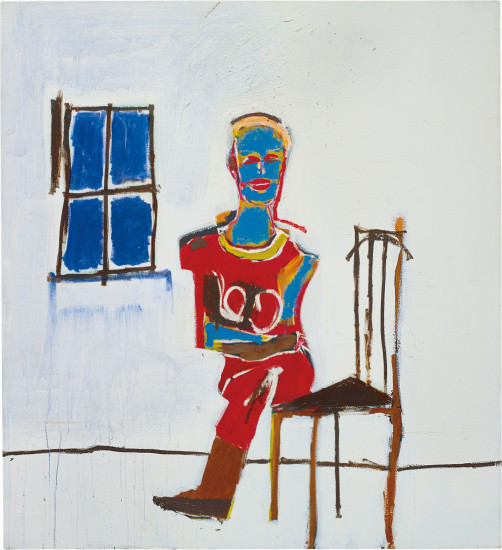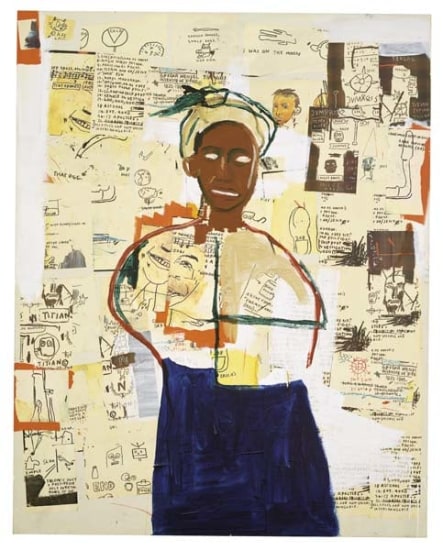Property from the Estate of Jean-Michel-Basquiat Jean-Michel-Basquiat Untitled (Venus 2000 B.C.) acrylic and oilstick on canvas mounted on tied wood supports 60 1/4 x 59 1/4 in. (153 x 150.5 cm.) Executed circa 1982.
Provenance Acquired from the artist by the present owner Literature Richard D. Marshall and Jean-Louis Prat, Jean-Michel-Basquiat, Vol. I, Paris, 1996, no. 5, p. 82 (illustrated) Richard D. Marshall and Jean-Louis Prat, Jean-Michel-Basquiat, 3rd Ed., Vol. II, Paris, 2000, no. 5, p. 131 (illustrated) Jordana Moore Saggese, Reading Basquiat: Exploring Ambivalence in American Art, Berkeley, 2014, p. 73 Catalogue Essay By the time Jean-Michel-Basquiat painted Untitled (Venus 2000 B.C.) in 1982 he had established himself as the impresario of the international art world within an exhilarating period of just a few years. Basquiat, born in 1960 to a Haitian father and a Puerto-Rican mother in New York, first gained notoriety in the late 1970s as the subversive graffiti-artist and street poet operating under the pseudonym SAMO©. A voracious autodidact, Basquiat soon shifted from spray painting enigmatic aphorisms across the Lower East Side of Manhattan to painting and drawing in the studio - first on reclaimed materials and later on canvas and paper. His powerful, iconoclastic works brilliantly captured the decadent zeitgeist of the 1980s New York underground scene and catapulted Basquiat to both critical acclaim and international stardom. Basquiat’s re-introduction of the human figure came at a time when the contemporary art field was dominated by the triumph of Minimalism and Conceptualism in the late 1960s and 70s, establishing him as one of main proponents of the Neo-Expressionist movement in New York during the 1980s. At the beginning of 1982, Basquiat was working out of the expansive studio in the basement of Annina Nosei's Prince Street gallery, where his first solo exhibition would be held that March. That year also found him travelling extensively, first in Modena, Italy and then later in Los Angeles where he worked out of a studio provided by his dealer there, Larry Gagosian, who introduced him to numerous prestigious West Coast collectors including Eli and Edythe Broad. 1982 was momentous for Basquiat, and Untitled (Venus 2000 B.C.), executed then, resonates with all the creative energies and artistic momentum that he manifested from coast to coast and around the world. Untitled (Venus 2000 B.C.) is executed in acrylic and oilstick on a canvas that has been stretched over a rudimentary wooden support. Basquiat’s connection to the street and to its immediacy did not suddenly dissipate once he began working out of a proper studio. Rather, he found a way to incorporate many of those same elements which imbued his graffiti with such gravitas into his paintings. Building such a jury-rigged stretcher for his Untitled (Venus 2000 B.C.) is a clear indication that while his paintings were beginning to sell for substantial sums of money, his creative drive was not to be sanitized by his commercial successes. His art was both derived from, and created out of, the detritus of the Lower East Side and global environs that he called home. The purity of the materials with which he executed Untitled (Venus 2000 B.C.) imbues the work with a palpable rawness. Basquiat’s audience responded enthusiastically to these new supports. Rene Ricard exclaimed that, "He's finally figured out a way to make a stretcher...that is so consistent with the imagery...they do look like signs, but signs for a product modern civilization has no use for." (Rene Ricard, “The Pledge of Allegiance,” Artforum, vol. XXI, no. 3, November 1982, p. 48) The painted composition of Untitled (Venus 2000 B.C.) is comprised of a myriad of Basquiat’s most potent symbols. Notably, the eponymous Venus figure of the title dominates the canvas. For Basquiat, “Venus” always represented his girlfriend, Suzanne Mallouk whom he first met back in 1980 at the Manhattan dive bar Night Birds. Venus, the Roman goddess, representing Suzanne, the embodiment of love and sexuality, does so only as a distinct outline. Basquiat does not render Venus in her traditionally voluptuous and enchanting man
Property from the Estate of Jean-Michel-Basquiat Jean-Michel-Basquiat Untitled (Venus 2000 B.C.) acrylic and oilstick on canvas mounted on tied wood supports 60 1/4 x 59 1/4 in. (153 x 150.5 cm.) Executed circa 1982.
Provenance Acquired from the artist by the present owner Literature Richard D. Marshall and Jean-Louis Prat, Jean-Michel-Basquiat, Vol. I, Paris, 1996, no. 5, p. 82 (illustrated) Richard D. Marshall and Jean-Louis Prat, Jean-Michel-Basquiat, 3rd Ed., Vol. II, Paris, 2000, no. 5, p. 131 (illustrated) Jordana Moore Saggese, Reading Basquiat: Exploring Ambivalence in American Art, Berkeley, 2014, p. 73 Catalogue Essay By the time Jean-Michel-Basquiat painted Untitled (Venus 2000 B.C.) in 1982 he had established himself as the impresario of the international art world within an exhilarating period of just a few years. Basquiat, born in 1960 to a Haitian father and a Puerto-Rican mother in New York, first gained notoriety in the late 1970s as the subversive graffiti-artist and street poet operating under the pseudonym SAMO©. A voracious autodidact, Basquiat soon shifted from spray painting enigmatic aphorisms across the Lower East Side of Manhattan to painting and drawing in the studio - first on reclaimed materials and later on canvas and paper. His powerful, iconoclastic works brilliantly captured the decadent zeitgeist of the 1980s New York underground scene and catapulted Basquiat to both critical acclaim and international stardom. Basquiat’s re-introduction of the human figure came at a time when the contemporary art field was dominated by the triumph of Minimalism and Conceptualism in the late 1960s and 70s, establishing him as one of main proponents of the Neo-Expressionist movement in New York during the 1980s. At the beginning of 1982, Basquiat was working out of the expansive studio in the basement of Annina Nosei's Prince Street gallery, where his first solo exhibition would be held that March. That year also found him travelling extensively, first in Modena, Italy and then later in Los Angeles where he worked out of a studio provided by his dealer there, Larry Gagosian, who introduced him to numerous prestigious West Coast collectors including Eli and Edythe Broad. 1982 was momentous for Basquiat, and Untitled (Venus 2000 B.C.), executed then, resonates with all the creative energies and artistic momentum that he manifested from coast to coast and around the world. Untitled (Venus 2000 B.C.) is executed in acrylic and oilstick on a canvas that has been stretched over a rudimentary wooden support. Basquiat’s connection to the street and to its immediacy did not suddenly dissipate once he began working out of a proper studio. Rather, he found a way to incorporate many of those same elements which imbued his graffiti with such gravitas into his paintings. Building such a jury-rigged stretcher for his Untitled (Venus 2000 B.C.) is a clear indication that while his paintings were beginning to sell for substantial sums of money, his creative drive was not to be sanitized by his commercial successes. His art was both derived from, and created out of, the detritus of the Lower East Side and global environs that he called home. The purity of the materials with which he executed Untitled (Venus 2000 B.C.) imbues the work with a palpable rawness. Basquiat’s audience responded enthusiastically to these new supports. Rene Ricard exclaimed that, "He's finally figured out a way to make a stretcher...that is so consistent with the imagery...they do look like signs, but signs for a product modern civilization has no use for." (Rene Ricard, “The Pledge of Allegiance,” Artforum, vol. XXI, no. 3, November 1982, p. 48) The painted composition of Untitled (Venus 2000 B.C.) is comprised of a myriad of Basquiat’s most potent symbols. Notably, the eponymous Venus figure of the title dominates the canvas. For Basquiat, “Venus” always represented his girlfriend, Suzanne Mallouk whom he first met back in 1980 at the Manhattan dive bar Night Birds. Venus, the Roman goddess, representing Suzanne, the embodiment of love and sexuality, does so only as a distinct outline. Basquiat does not render Venus in her traditionally voluptuous and enchanting man

.jpg)









Try LotSearch and its premium features for 7 days - without any costs!
Be notified automatically about new items in upcoming auctions.
Create an alert